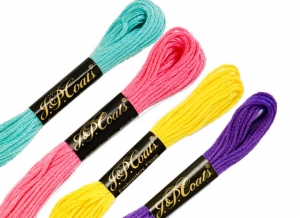In the early 1800's, James and Patrick specialised in making the cotton yarns that were used for loom heddles (in a street that became known as Cotton Street). James Coats also set up a business in the early 1820's dealing in silks (yarns and cloth), in particular for the ‘cork’ or tambour trade. And in 1826, he set up a business based at Ferguslie, Ayrshire, for the production of cotton yarns. This business was called J. Coats.
James Coats retired in 1830 and his sons, James, Peter, Thomas and Andrew took over the company, re-naming it J. & P. Coats. The company specialised in producing a wide range of threads especially for crochet, embroidery and sewing. Each of the brothers was concerned with a particular aspect of the company, such as product development (James), sales and accounts (Peter), technology (Thomas), etc.
Andrew had the responsibility for developing international sales, including in North America. As a result of his activities and from the 1830's onwards, J. & P. Coats was sending commercial agents to the USA and Canada. Despite restrictions on the production and sale of cotton due to the American Civil War (1861-1865), Coats continued to grow in the USA and in 1866 J. & P. Coats opened a mill in Pawtucket, Rhode Island, to produce a wide range of threads. It was in the 1880's that more USA based mills were added and the development of the famous Coats trade cards to spread information about their products took off.
In 1890, J. & P. Coats was publicly floated on the London Stock exchange and the company started to build and acquire more companies abroad, such as one at Borgonya, near Barcelona in Spain. In 1896, the two companies of J. &. P. Coats and that of Clark Thread Co. started working together, but they retained their respective trading names. At the same time they started to take over various other British firms and opened new factories in Brazil, Canada, Portugual and Russia. In the USA, Coats and Clark were regarded as the Scottish thread giants, whose merger made it harder for ‘native’ USA thread companies to grow. So much so, that in 1913 the USA government filed a suit against Coats and Clark for trade violations, notably price-fixing. This led in 1914 to the official separation of the USA based operations from those in Scotland, although both groups remained in close contact.
During the twentieth century, Coats and Clark built thread companies in countries as far apart as Latvia, Pakistan, Philippines, South Africa, Turkey, Venezuela and Vietnam. In 1952, J. & P. Coats and Clark Thread Co. fully merged their names and their products, including embroidery threads, and these became known as Coats and Clark. This merger was followed by a merger in 1961 with Patons and Baldwins, and the creation of the company of Coats Patons. Further mergers followed, and in 1986 Coats Patons merged with Vantona Viyella to create Coats Viyella. This was followed in 2003 when the Guinness Peat Group plc took over the firm.
Embroidery threads are still being produced under the trade name of J. & P. Coats (in the USA six-stranded cotton thread is known as floss or embroidery floss and Coats sells its products as Coats Embroidery Floss).
Sources:
- KIM, Dong-Woon (1994). 'From a family partnership to a corporate company: J. & P. Coats, thread manufacturers,' Textile History, Autumn 1994, vol. 25, issue 2, pp. 185–225.
- http://www.makeitcoats.com/en-us/about/historyandheritage (retrieved 16 April 2016).
- https://en.wikipedia.org/wiki/Clark_Thread_Company_Historic_District (retrieved 16 April 2016).
- http://www.coats.com/index.asp?pageid=20 (retrieved 16 April 2016).
Digital source of illustration (retrieved 28 June 2016).
GVE

